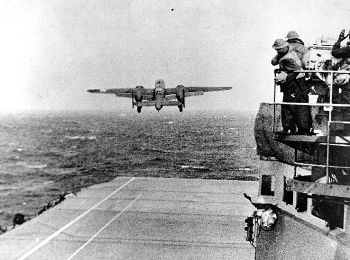
Doolittle Raid B-25 Taking Off from USS Hornet 4/18/1942 (Public Domain)
 Doolittle Raid B-25 Taking Off from USS Hornet 4/18/1942 (Public Domain) |
Ironically consistent with the lieutenant colonel's last name, the raid actually did little damage. Yet the Japanese command was so humiliated that it overreacted, first by killing hundreds of thousands of Chinese in retaliation for assistance provided to the B-25 crews, many of whom had landed in mainland China as they were running out of fuel. Tokyo's intended response also included shoring up its Pacific defenses with an invasion of Midway Island. Japan's plan was not merely to take over this strategic outpost, from which they could protect the homeland and renew attacks on Hawaii, but also to wipe out the three remaining U.S. aircraft carriers, remnants of the Pacific Fleet which had escaped destruction in the December 7, 1941, attack on Pearl Harbor, thereby assuring Japanese naval dominance for years to come.
The tables were turned, however, in the Battle of Midway, only a month and a half after the Doolittle Raid, when the three remaining U.S. carriers defeated four Japanese carriers and routed the invasion fleet. That conflict's climax saw U.S. dive-bomber destruction of three Japanese carriers in about as many minutes. The fourth carrier was located and destroyed a few hours later. Japan's navy would never again hold sway in the Pacific and was thereafter on the defensive until the conclusion of the war three years later. None of this might have happened, certainly not as decisively as it did, had it not been for the daring attack by Doolittle and his raiders on 4/18/1942.